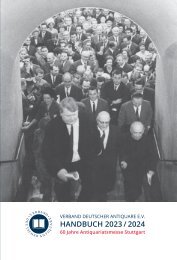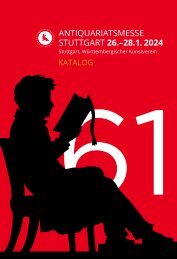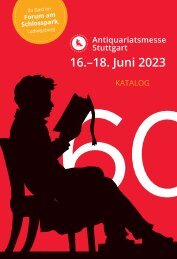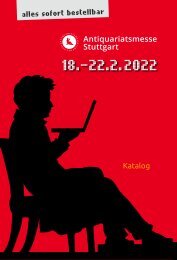Antiquariatsmesse Stuttgart 2021 - Katalog
Katalog zur Antiquariatsmesse Stuttgart 2021: Die Antiquariatsmesse Stuttgart als größtes Schaufenster für wertvolle Objekte des Antiquariats- und Graphikhandels in Deutschland findet in diesem Jahr in ungewohnter Form statt. Da eine Präsenzmesse nicht stattfinden kann, haben sich 76 Kollegen aus Deutschland, Großbritannien, Österreich, Frankreich, der Schweiz, den Niederlanden, den Vereinigten Staaten und aus Australien zusammengefunden, um einen Katalog für die Messe zu erstellen und gleichzeitig ein Angebot für eine virtuelle Messe zusammengetragen. Der Katalog wird am 7. Januar 2021 an interessierte Kunden verschickt, die virtuelle Messe öffnet ihre „digitalen Pforten“ am 29. Januar 2021 um 12.00 Uhr unter www.antiquariatsmesse-stuttgart.de
Katalog zur Antiquariatsmesse Stuttgart 2021: Die Antiquariatsmesse Stuttgart als größtes Schaufenster für wertvolle Objekte des Antiquariats- und Graphikhandels in Deutschland findet in diesem Jahr in ungewohnter Form statt. Da eine Präsenzmesse nicht stattfinden kann, haben sich 76 Kollegen aus Deutschland, Großbritannien, Österreich, Frankreich, der Schweiz, den Niederlanden, den Vereinigten Staaten und aus Australien zusammengefunden, um einen Katalog für die Messe zu erstellen und gleichzeitig ein Angebot für eine virtuelle Messe zusammengetragen.
Der Katalog wird am 7. Januar 2021 an interessierte Kunden verschickt, die virtuelle Messe öffnet ihre „digitalen Pforten“ am 29. Januar 2021 um 12.00 Uhr unter www.antiquariatsmesse-stuttgart.de
Erfolgreiche ePaper selbst erstellen
Machen Sie aus Ihren PDF Publikationen ein blätterbares Flipbook mit unserer einzigartigen Google optimierten e-Paper Software.
Cupids, Angels and Masks Engraved by Bosse
Farinati, Paolo. Diverses Figures a l’eau forte de
petits Amours, Anges vollants, et Enfans. Ensemble
plus.rs sortes de Masques de l’invention de Paul
Farinaste Italien. Paris, A. Bosse, 1644. Oblong 4to,
(197 × 250 mm), ll. 30 of numbered engraved plates;
some spotting in the plates; early 18th century
vellum-backed marbled boards, spine lettered in
manuscript; from the Macclesfield library; a fine,
large and wide-margined copy. € 2500,–
First edition of a very appealing series of engravings by
Abraham Bosse after designs by the Italian artist and
draughtsman Paolo Farinati (1524–1606). Farinati’s
chiaroscuro drawings were often used as „modelli“ and
employed in sculptural, architectural, art and book illustration.
The plates depict small cupids and angels (22
plates) and masks (8 plates), and found frequent use in
ornamentation. Paolo Farinati was a highly productive
painter and draughtsman from Verona, whose paintings
are preserved in many churches. – Blum, L’Oeuvre
gravé d’Abraham Bosse, 940–943; Cicognara 2028; see
Berlin 4355; Saur XXXVII, pp. 53–54.
Wolf, Ferdinand. Die Verfertigung der Handfeuerwaffen
nebst einer geschichtlichen Darstellung ihrer
Einrichtung von der Entstehung bis auf die neueste
Zeit. Mit achtzehn Kupfertafeln. Karlsruhe,
Christian Theodor Groos, 1832. Two volumes, 8vo
(210 × 127 mm) and large landscape Folio (276 × 455
mm), pp. xx, 451, [1] errata; [viii], 18 plates with 250
illustrations after drawings by the author; bound
in matching but not identical contemporary full
red hatched morocco: 8vo with central gilt lozenge
and gilt borders; folio with gilt fillets and blind
roll; upper cover lettered gilt direct, rebacked; title
page verso of the second volume with stamp of the
Fürstenbergische Hofbibliothek in Donaueschingen.
€ 2500,–
A finely bound copy of this important technical assessment
of the history and production of small arms
in Germany. This treatise on arms manufacture and a
compendium of accompanying engraved schematics,
form a remarkably detailed appraisal of the development
of weapon manufacture at the outset of the European
industrial revolution. Wolf outlines the materials
necessary for gun-making, including the production
and availability of iron. He describes the manufacturing
processes of each part of this military weaponry, and
concludes with a depiction of different kinds of rifles
and their evolution.
The fine engravings pertain to the manufacture of small
arms, machines and other equipment, with detailed
information about the evolution of gun making, as
well as an explication of the machines used and their
constituent parts.
The author Ferdinand Wolf (1796–1861) was captain
in the Grand Ducal Line Infantry Regiment, and was
for two years a commander of the rifle factory in St.
Blasien. The factory, which was based in a converted
abbey, was one of the earliest sites of industrial manufacturing
in Germany. It had been founded in the first
decade of the century by mechanic and inventor Johann
Georg Bodmer, with the financial backing of David von
Eichthal (1776–1851), „one of the leading industrialists
in Baden in the first half of the 19th century“ (NDB
IV, p. 386).
243






